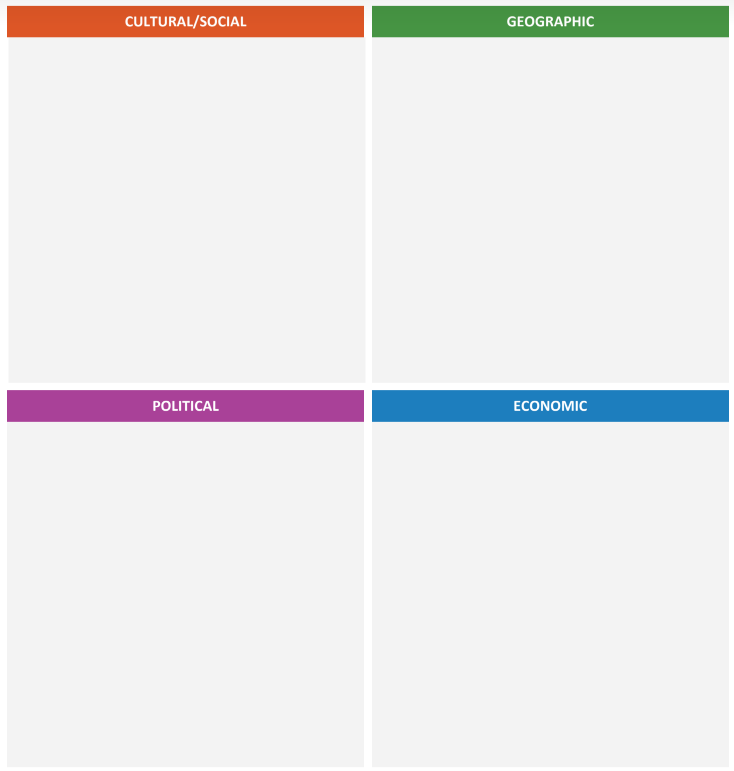Integrate Four Disciplinary Perspectives
We designed the Area Study Organizer to help students integrate knowledge from multiple disciplines when studying a geographical or cultural area. This strategy was inspired by how people examine issues in academic subjects such as Middle Eastern and European Studies.
Area studies
Area studies, such as Middle Eastern Studies or European Studies, draw on multiple disciplinary traditions. This interdisciplinarity presents challenges and opportunities. The challenge is that each discipline has its own "habits of mind" (Galloway, Lawrence, & Moje, 2013). It can be quite challenging for students to keep track of the methods used in each discipline to investigate and analyze the world. If we can help them to track and reflect on these methods, however, students can develop a deeper understanding of a topic by approaching it from different angles. Furthermore, reflecting on interdisciplinary work provides a great opportunity to reflect on the nature of knowledge generation in different traditions.
We have curated essential questions and reflection items in cultural/social studies, geography, economics, and political studies, which we present on the first page of the Area Study Organizer. These questions are organized by the disciplinary-lenses through which students can look. As always, we encourage you to adapt the strategy. Maybe, given your students' needs, it makes sense to start with a shorter description of the four dimensions or focus only on one at a time.

How to Use the Area Study Organizer
This strategy template is similar to the mnemonic organizers, Grapes and PERSIA. It aims to help students organize information about an area into four conceptual categories.
- The teacher and students define or select the area and time period.
- The class reads the first page of the organizer and discusses the questions and disciplinary perspectives.
- Students or student groups read one or more texts about the area. While reading, they use the four boxes to note down relevant information (see Figure 2).

Exploring Multiple Perspective and Texts
Studying a cultural area is complicated and usually part of a weeklong unit that requires students to integrate information across texts, maps, videos, and other information sources. This strategy can sensitize students to how our perspective may influence how we approach a topic and sometimes explain conflicting information or perspectives. For instance, you might ask students to use this organizer to take notes on texts related to a region from an economic and cultural perspective. The evaluation of the region may vary according to the lens one uses. So, for example, you might use this strategy to:
- Help students explore one question, but with texts that push them to integrate knowledge across two or more disciplines.
- Help students develop expertise. For instance, you can assign a role to each student in a group (i.e., the cultural/social scientist, the geographers, the political scientists, and the economists). Then, have them take turns presenting information from their perspectives. Alternate roles next time.
What do students need to become critical consumers and producers of knowledge within a discipline? And how can teachers support them in achieving this?
Download, Adapt, and Share
We have made an editable version of the graphic organizer available for free (click the download link to the Word version below). We believe that a strategy without a purpose is no strategy at all. Think carefully about how you want to use this strategy to help students become critical consumers and producers of knowledge in your discipline. After reflecting on these questions, consider if there are parts of the strategy template that you would like to change.
References
Galloway, E. P., Lawrence, J. L. and Moje, E. B. Research in Disciplinary Literacy: Challenges and Instructional Opportunities in Teaching Disciplinary Texts. in Adolescent Literacy in the Era of the Common Core: From Research into Practice (eds. Ippolito, J., Lawrence, J. L. & Zaller, C.) (Harvard Educational Press, 2013). https://readingways.org/adolescent-literacy-in-the-era-of-the-common-core-2/

